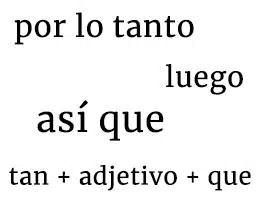 The idea of link is used in the field of grammar to refer to the element that allows sentences, phrases or words to be linked . This union is made possible by a syntactic function.
The idea of link is used in the field of grammar to refer to the element that allows sentences, phrases or words to be linked . This union is made possible by a syntactic function.
A consecutive link is one that establishes a consequential link between two statements . What it does is introduce a segment that is the effect or cause of the preceding segment.
Different phrases and conjunctions can be used as a consecutive link. For example: “I will go to the party because I have committed to doing so.” In this case, “well” is the consecutive link that links the two parts of the expression ( “I will go to the party” and “I have committed to doing it” ). The fact of attending the event, in this framework, is a consequence of the commitment previously assumed by the speaker.
Let's look at another example : “It's cold so I'll go out with a coat.” As can be seen, the phrase “so” acts as a consecutive link, relating the statements “It's cold” and “I'll go out with a coat.” The decision to resort to warm clothing is a result of the low temperatures perceived previously.
“I don't have money, therefore I won't go on vacation” is another expression that includes a consecutive link: “therefore.” Since the individual lacks financial resources, he will not be able to travel to enjoy his days off.
We can even find a consecutive link in René Descartes ' famous phrase that translates as “I think, therefore I am.” The French philosopher states that a person “is” since he “thinks.” The consecutive link used is “then” , which links the act of thinking and existence.
At this point it is important to point out that the meaning of the word then is not what we usually give it in everyday speech, that is, "after", but rather we must understand it as a synonym for "therefore, therefore." In other words, we could simplify Descartes' phrase into: «I think; therefore, I exist.
Consecutive links belong to a much larger group, that of subordinating links , which are characterized by connecting a proposition considered primary to a secondary one, which is subordinate to it. Subordinating links can be adverbs, pronouns, conjunctive phrases or conjunctions and are among the words and constructions that we use most frequently in everyday speech.
 It is worth mentioning that of the long list of consecutive links, not all of them are common in colloquial language , nor do we find them in ordered sentences without pauses. For example: the link then , mentioned above, is extremely rare in conversation, at least outside of academia; instead we usually find so that or, less frequently, therefore .
It is worth mentioning that of the long list of consecutive links, not all of them are common in colloquial language , nor do we find them in ordered sentences without pauses. For example: the link then , mentioned above, is extremely rare in conversation, at least outside of academia; instead we usually find so that or, less frequently, therefore .
The consecutive link can also include the verb to be in the middle to make it more enjoyable in oral communication , as can be seen in the following example: «He told me clearly that he did not plan to continue working with us, so I have already to look for a replacement .
Another of the most used consecutive links is so + adjective + that , and it serves to present a quality of a noun that, given its intensity, generates a consequence , expressed at the end of the sentence: «This computer is so powerful that I never notice a decrease in fluency in video games» . If we wanted to decompose this sentence into two, it would be necessary to dispense with the link, since it only makes sense if both propositions are present.
A variant of this consecutive connection consists of using an adverb instead of an adjective. For example: "He explained it to me so carefully that I will never forget it." Note that in this case confusion may arise with the term fast , since it can function as an adjective ( "He is so fast" ) or an adverb ( "He speaks so quickly" ).
